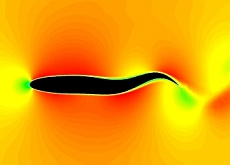Blimp will be a fish out of water

Airship development may be at a turning point thanks to a new project at the Federal Laboratories for Materials Testing and Research near Zurich.
A blimp – a small airship – that moves through the air like a fish in water could be the successor to the Zeppelin, providing a quiet and energy-efficient means of transport.
More than a decade ago, film director Emir Kusturica imagined a fish floating through his movie Arizona Dream. Today, his flight of fancy is on the road to becoming reality – well almost.
Researchers at the federal laboratories in Dübendorf were looking for applications for their electrically activated polymers (EAPs). These are thin materials that change form when an electric current is passed through them and return to their original shape when power is cut off.
The most obvious use of these polymers would be to develop artificial muscles. But for the team of engineers led by Silvain Michel, lighter-than-air craft seemed to be another potential application of the technology.
Conventional airships are considered wasteful of energy and noisy, handicaps that could be overcome by using flexible materials. The propellers that blimps use also create turbulent airflows, making them harder to handle.
Further inspiration came from nature – and fish. Until now, no one had really considered the idea of developing a non-rigid airship that used amphibious movements as its propulsion.
Swimming along
The idea would to use EAPs as muscles incorporated in the airship’s skin, making the blimp “swim” through the air and avoiding the use of propellers.
According to Michel, fish and dolphins are the most efficient animals when moving through water, a fact that could be applied to flying machines since the physics involved is identical.
“Theoretically speaking, we have shown that it is possible,” he told swissinfo. “The real challenge is to see if it is technologically feasible and if the structure [of an airship] can withstand the stresses and strains involved.”
In his underground laboratory, he holds up one of the hand-made polymers. It is a clear acrylic-based plastic film coated with a black graphite solution.
It seems simple, but there are problems to overcome, as Michel explains. The EAPs still lack resistance and are prone to overheating, destroying their capacity to regain their shape.
So far, the engineers have successfully trialled a first prototype model, using the polymers to activate the miniature blimp’s control surfaces at the rear. But propellers remain the only means of propulsion for the moment.
Fishy prototype
Michel hopes to get a slow-moving six-metre prototype using fish propulsion off the ground in the next two years. Problems with aerodynamics, structural mechanics and aerostatics are some of the issues facing the researchers before their blimp takes to the air indoors.
Commercial development as such is much further off.
“A product with this technology will not be available within the next five to ten years,” Michel admits. “There are many hurdles to overcome before this project becomes commercially viable.”
However, the perspectives remain interesting. If the polymers were used to move an airship, they would be twice as efficient as a combustion engine, and the blimp’s upper surface could carry solar cells to recharge batteries.
What the blimp would actually be used for remains unclear, although advertising for beer, cars or tyres is not necessarily the first choice. Suggestions include, if reliability problems can be overcome, replacing satellites for communications or helicopters for lengthy missions.
But Michel has a personal favourite: observing animals.
“You really need equipment that is noiseless to watch animals,” he says. “Our platform would be perfect for that.”
swissinfo, Scott Capper in Dübendorf
The Federal Laboratories for Materials Testing and Research are part of Switzerland’s Federal Institutes of Technology.
The three sites in Dübendorf, St Gallen and Thun specialize in applied as well as focused research and development, and provide services in the field of materials science and technology.
Research is grouped in five programmes: nanotechnology, adaptive materials systems, materials for health and performance, materials for energy technologies and atmosphere.
More than 800 people work for the laboratories, and over 200 PhD candidates and undergraduates carry out research there.
An airship is an aircraft that stays aloft primarily by means of a cavity (usually quite large) filled with a gas of lesser density than the surrounding atmosphere.
They were the first aircraft to make controlled, powered flight, and were used particularly from 1900 to the 1930s.
However, airship use decreased over time as airplanes surpassed their capabilities.
In addition they suffered a series of high profile accidents — most notably the spectacular burning of the Hindenburg.
Today airships are used in a variety of niche applications, particularly advertising.

In compliance with the JTI standards
More: SWI swissinfo.ch certified by the Journalism Trust Initiative


You can find an overview of ongoing debates with our journalists here. Please join us!
If you want to start a conversation about a topic raised in this article or want to report factual errors, email us at english@swissinfo.ch.